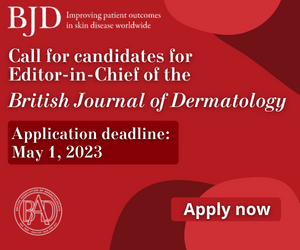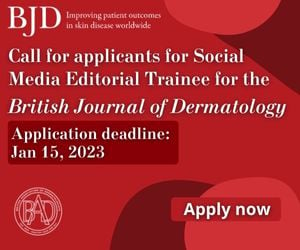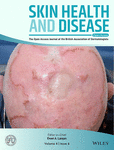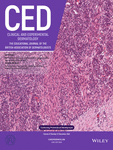Journal list menu
Export Citations
Download PDFs
Editor's Choice
EDITORIALS
Toxic epidermal necrolysis: the past, the guidelines and challenges for the future
- Pages: 1171-1173
- First Published: 18 June 2016
New GRAPPA recommendations for the management of psoriasis and psoriatic arthritis: process, challenges and implementation
- Pages: 1174-1178
- First Published: 18 June 2016
COMMENTARIES
Is education enough to improve quality of life in people with chronic inflammatory skin conditions?
- Page: 1179
- First Published: 18 June 2016
Linked Article: Pickettet al. Br J Dermatol 2016; 174: 1228–1241.
Rising interest in the field of paediatric psoriasis
- Pages: 1180-1181
- First Published: 18 June 2016
Linked Article: Burden et al. Br J Dermatol 2016; 174: 1242–1257.
Is screening for basal cell carcinoma worthwhile? Too soon to tell
- Pages: 1181-1182
- First Published: 18 June 2016
Linked Article: Hoorens et al. Br J Dermatol 2016; 174: 1258–1265.
Basal cell carcinoma screening drives a comprehensive approach to skin cancer
- Pages: 1182-1183
- First Published: 18 June 2016
Linked Article: Hoorens et al. Br J Dermatol 2016; 174: 1258–1265.
A new option on the horizon for the treatment of psoriasis: it is needed, but not at any price
- Pages: 1183-1184
- First Published: 18 June 2016
Linked Article: Papp et al. Br J Dermatol 2016; 174: 1266–1276.
How common is tuberous sclerosis complex?
- Pages: 1184-1185
- First Published: 18 June 2016
Linked Article: Hong et al. Br J Dermatol 2016; 174:1282–1289.
What is the true mortality from pemphigus?
- Pages: 1185-1186
- First Published: 18 June 2016
Linked Article: Hsu et al. Br J Dermatol 2016; 174:1290–1298.
Acne vulgaris: an inflammasomopathy of the sebaceous follicle induced by deviated FoxO1/mTORC1 signalling
- Pages: 1186-1188
- First Published: 18 June 2016
Linked Article: Agamia et al. Br J Dermatol 2016; 174: 1299–1307.
Inherited susceptibility to melanoma: insights from a high-risk Austrian cohort
- Pages: 1188-1190
- First Published: 18 June 2016
Linked Article: Müller et al. Br J Dermatol 2016; 174:1308–1317.
Serum chemokines herald disease activity and treatment response in vitiligo patients
- Pages: 1190-1191
- First Published: 18 June 2016
Linked Article: Wang et al. Br J Dermatol 2016; 174: 1318–1326.
A new biomarker for psoriasis
- Pages: 1191-1192
- First Published: 18 June 2016
Linked Article: Watanabe et al. Br J Dermatol 2016; 174: 1327–1336.
Is targeting interleukin-31 a cure for the itch? Lessons from amyloidosis
- Pages: 1192-1193
- First Published: 18 June 2016
Linked Article: Tey et al. Br J Dermatol 2016; 174: 1345–1350.
GUIDELINES
U.K. guidelines for the management of Stevens–Johnson syndrome/toxic epidermal necrolysis in adults 2016
- Pages: 1194-1227
- First Published: 18 June 2016
Reviews
SYSTEMATIC REVIEWS
Education to improve quality of life of people with chronic inflammatory skin conditions: a systematic review of the evidence
- Pages: 1228-1241
- First Published: 02 February 2016
What's already known about this topic?
- People with chronic inflammatory skin conditions can experience poor health-related quality of life (HRQoL).
- There is mixed evidence about whether patient education improves HRQoL.
What does this study add?
- Education often focuses on information about a condition and its treatment. This systematic review examines outcomes of education that specifically aims to improve HRQoL or includes elements that could improve HRQoL.
- The limited available evidence shows inconsistent HRQoL effects and the need for more theoretically based interventions.
Linked Comment: Bundy. Br J Dermatol 2016; 174: 1179.
Plain language summary available online
The epidemiology of childhood psoriasis: a scoping review
- Pages: 1242-1257
- First Published: 01 March 2016
What's already known about this topic?
- The prevalence of psoriasis in children is lower than in adults, but the significant number of adults who first developed skin disease in childhood supports the frequent persistence of psoriasis into adulthood.
- Genetic and environmental factors both play an important role in the onset of psoriasis.
- Disease associations, such as obesity, are an important area of current research activity.
What does this study add?
- Mapping has shown a dramatic increase in the number of published studies over the past 25 years.
- Studies have been concentrated in Europe, Asia and North America. These studies have largely been case series or cross-sectional studies.
- Specific studies with standardized methodologies are needed to provide data on the frequency, clinical presentation, risk factors, associated diseases and long-term outcomes for childhood-onset psoriasis.
Linked Comment: Dowlatshahi and Wakkee. Br J Dermatol 2016; 174: 1180–1181.
REVIEW ARTICLE
Is early detection of basal cell carcinoma worthwhile? Systematic review based on the WHO criteria for screening
- Pages: 1258-1265
- First Published: 12 February 2016
What's already known about this topic?
- Basal cell carcinoma (BCC) is the most common (skin) cancer in Europe. Its incidence is rising dramatically, and it is associated with an important direct treatment cost for healthcare budgets.
- BCCs slowly increase in size, with a median increase in diameter of 0·5 mm over 10 weeks.
- Delays in diagnosis and appropriate treatment are the most important underlying causes of giant BCC and metastasis.
What does this study add?
- Early detection and starting of adequate treatment of BCC seem to be crucial for BCC of the face, more specifically in the H-zone.
- Small changes in size can affect treatment options (e.g. type of surgery), their effectiveness and the associated costs.
Linked Comment: Linos and Chren. Br J Dermatol 2016; 174: 1181–1182.
Linked Comment: Wisco and Adelson. Br J Dermatol 2016; 174: 1182–1183.
Plain language summary available online
Original articles
CLINICAL TRIALS
A randomized phase 2b trial of baricitinib, an oral Janus kinase (JAK) 1/JAK2 inhibitor, in patients with moderate-to-severe psoriasis
- Pages: 1266-1276
- First Published: 22 January 2016
What's already known about this topic?
- Psoriasis is a common, chronic, immune-mediated inflammatory skin disease.
- Key cytokines involved in the pathogenesis of psoriasis use the Janus kinase–signal transducer and activator of transcription (JAK-STAT) pathway.
- New safe and effective therapies are needed for patients.
What does this study add?
- Baricitinib, a selective JAK1/JAK2 inhibitor, demonstrates clinical efficacy in the treatment of psoriasis.
- Baricitinib was well tolerated over the 24-week trial period.
Linked Comment: Albrecht and Gerdes. Br J Dermatol 2016; 174: 1183–1184.
Oral alitretinoin treatment in patients with palmoplantar pustulosis inadequately responding to standard topical treatment: a randomized phase II study
- Pages: 1277-1281
- First Published: 22 January 2016
What's already known about this topic?
- Alitretinoin is a retinoid X receptor and retinoid A receptor agonist with effects on cutaneous inflammation and hyperkeratinization.
- Findings from earlier uncontrolled studies of alitretinoin indicate that it could be a meaningful treatment option for palmoplantar pustulosis.
What does this study add?
- Although the results were unexpected based on previous studies of alitretinoin in the treatment of palmoplantar pustulosis, this study provided no evidence to support further exploration of alitretinoin in the treatment of severe palmoplantar pustulosis.
EPIDEMIOLOGY
An estimation of the incidence of tuberous sclerosis complex in a nationwide retrospective cohort study (1997–2010)
- Pages: 1282-1289
- First Published: 23 January 2016
What's already known about this topic?
- Patients with tuberous sclerosis complex (TSC) develop systemic hamartomas with significant psychosocial burdens.
- Two small epidemiological studies have estimated the incidence of TSC to be 0·28–0·56 per 100 000 person-years (PY) in the U.S.A.
What does this study add?
- This 14-year-long longitudinal study estimated the incidence of TSC in Taiwan to be 0·153 per 100 000 PY.
- The prevalence of TSC in 2010 in Taiwan was 1·58 in 100 000.
- A significantly lower risk of peptic ulcer is found in patients with TSC compared with healthy controls.
Linked Comment: Morrison and Donnelly. Br J Dermatol 2016; 174: 1184–1185.
Comorbidities and inpatient mortality for pemphigus in the U.S.A.
- Pages: 1290-1298
- First Published: 11 February 2016
What's already known about this topic?
- Pemphigus is associated with morbidity and mortality.
- The inpatient comorbidities and mortality of pemphigus have not been well described.
What does this study add?
- The present study revealed novel associations between pemphigus and numerous medical and mental health comorbidities in children and adults, including infections and autoimmune, cardiovascular, endocrine, haematological and neuropsychiatric disorders.
- Although inpatient mortality rates for patients with pemphigus were higher than for those without pemphigus, we found substantially lower inpatient mortality rates than traditionally reported in pemphigus.
Linked Comment: Murrell. Br J Dermatol 2016; 174: 1185–1186.
Plain language summary available online
TRANSLATIONAL RESEARCH
Skin expression of mammalian target of rapamycin and forkhead box transcription factor O1, and serum insulin-like growth factor-1 in patients with acne vulgaris and their relationship with diet
- Pages: 1299-1307
- First Published: 22 January 2016
What's already known about this topic?
- A high-glycaemic-load diet and insulin-like growth factor-1 play roles in the induction of acne.
- Increased mammalian target of rapamycin (mTOR)C1 signalling has been reported in patients with acne compared with healthy controls.
What does this study add?
- This study provides immunohistochemical evidence of increased cytoplasmic expression of the metabolic transcription factor FoxO1 and increased expression of mTOR in the skin of patients with acne.
- We provide experimental evidence supporting the hypothesis of decreased nuclear FoxO1 signalling in patients with acne.
What is the translational message?
- Nutritional therapy for acne should (i) normalize total calorie intake, (ii) lower glycaemic load and (iii) restrict total dairy protein consumption.
- Understanding nutrient signalling may help dermatologists to understand the central role of the Western diet in the pathogenesis and treatment of acne.
- Our results may offer novel therapeutic strategies for the treatment of acne based on upregulation of nuclear FoxO1.
Linked Comment: Melnik. Br J Dermatol 2016; 174: 1186–1188.
Plain language summary available online
Characterization of patients at high risk of melanoma in Austria
- Pages: 1308-1317
- First Published: 22 January 2016
What's already known about this topic?
- Melanoma risk is determined by environmental and genetic risk factors.
- The frequency and type of disease-causing gene mutations vary between different countries.
What does this study add?
- This is the first comprehensive description of Austrian patients at high risk of melanoma.
- The heterogeneity of the different subgroups suggests diverse pathways.
- We present functional prediction of MC1R and CDK4 variants with unknown biological significance in high-risk patients, and three novel cases with MITF variants in high-risk patients.
What is the translational message?
- Identification of high-risk individuals helps to reduce mortality.
- The risk of melanoma is comprised of a complex interplay between genetic and environmental factors; however, genetic mutations associated with melanoma might differ from country to country.
- Knowledge of these mutations and adjustment of criteria for testing could be required for adequate risk assessments.
Linked Comment: Stefanaki and Stratigos. Br J Dermatol 2016; 174: 1188–1190.
Plain language summary available online
Increased expression of CXCR3 and its ligands in patients with vitiligo and CXCL10 as a potential clinical marker for vitiligo
- Pages: 1318-1326
- First Published: 23 January 2016
What's already known about this topic?
- A T-cell-mediated immune response is responsible for melanocyte destruction in vitiligo.
- CXCL10 is critical for the progression and maintenance of depigmentation in a mouse model of vitiligo.
What does this study add?
- CXCL9 and CXCL10, in parallel with their receptor, CXCR3, are present in patients with vitiligo and correlate with disease activity and severity.
- Serum CXCL10 may be a novel biomarker in monitoring disease activity and guiding treatment of progressive vitiligo.
What is the translational message?
- Blocking the CXCL10/CXCR3 chemotactic mechanism may present a new form of therapy for progressive vitiligo.
Linked Comment: Rashighi and Harris. Br J Dermatol 2016; 174: 1190–1191.
Plain language summary available online
Elevation of serum squamous cell carcinoma antigen 2 in patients with psoriasis: associations with disease severity and response to the treatment
- Pages: 1327-1336
- First Published: 29 January 2016
What's already known about this topic?
- Squamous cell carcinoma antigen (SCCA) belongs to the ovalbumin–serpin family.
- Serum SCCA level has been widely used as a tumour marker.
- Serum SCCA level is increased in patients with psoriasis.
What does this study add?
- SCCA2 level was significantly higher in patients with psoriasis than healthy volunteers in both skin and serum.
- Serum SCCA2 level was strongly correlated with psoriasis severity score and reflected treatment efficacy.
- Expression of SCCA2 was elevated in the epidermis of patients with psoriasis and its intensity was correlated with serum SCCA2 level.
- SCCA2 was strongly induced by T-helper (Th) 17-type cytokines in human keratinocytes.
What is the translational message?
- SCCA2 may be a useful biomarker in psoriasis, reflecting Th17-type inflammation.
Linked Comment: Yamanaka and Mizutani. Br J Dermatol 2016; 174: 1191–1192.
Plain language summary available online
MEDICAL DERMATOLOGY
Clinical significance of serum YKL-40 in Behçet disease
- Pages: 1337-1344
- First Published: 26 December 2015
What's already known about this topic?
- YKL-40, secreted by activated macrophages and neutrophils, is a potential biomarker of inflammation and endothelial dysfunction.
- Behçet disease (BD) is a chronic multisystemic inflammatory disease, characterized by neutrophil hyperactivation and endothelial injury with subsequent dysfunction.
What does this study add?
- Serum YKL-40 levels are increased in patients with BD and positively correlate with disease activity.
- YKL-40 may play a role in the pathophysiology of BD and could provide a useful marker for monitoring patients with BD.
Pathophysiology of pruritus in primary localized cutaneous amyloidosis
- Pages: 1345-1350
- First Published: 08 January 2016
What's already known about this topic?
- Itch is frequently associated with primary localized cutaneous amyloidosis (PLCA) and can be debilitating; its pathophysiology is unknown.
What does this study add?
- Small-fibre neuropathy is present in PLCA.
- Pruritus in PLCA is likely associated with hypersensitivity of cutaneous nerve fibres, which may be related to an increased expression of epidermal interleukin (IL)-31 receptors.
- Targeting IL-31 receptors is a potential therapeutic approach.
Linked Comment: Schreml. Br J Dermatol 2016; 174: 1192–1193.
GENERAL DERMATOLOGY
The 2016 International League of Dermatological Societies' revised glossary for the description of cutaneous lesions
- Pages: 1351-1358
- First Published: 23 January 2016
What's already known about this topic?
- A unifying language and precise descriptions are key to the practice of dermatology.
- The International League of Dermatological Societies (ILDS) first published a ‘Glossary of basic dermatology lesions’ in 1987.
What does this study add?
- This is an entirely updated and revised version of the 1987 ILDS glossary.
- The revised nomenclature is written with both dermatologists and nondermatologists in mind.
Carbon dioxide laser ablation of basal cell carcinoma with visual guidance by reflectance confocal microscopy: a proof-of-principle pilot study
- Pages: 1359-1364
- First Published: 23 January 2016
What's already known about this topic?
- Nonsurgical treatment including laser ablation of skin cancer is limited by lack of histologically confirmed clearance.
- Reflectance confocal microscopy provides noninvasive, in vivo imaging of skin with cellular-level resolution
What does this study add?
- Confocal microscopy can effectively map tumour margins preablation and also detect residual tumour postablation.
- Carbon dioxide laser ablation guided by confocal microscopy may represent a suitable alternative treatment for low-risk basal cell carcinoma in nonsurgical candidates.
PERSPECTIVES
Developing more open and equitable relationships with industry to improve advancements in clinical research in dermatology
- Pages: 1365-1369
- First Published: 18 June 2016
CASE REPORTS
Kaposi sarcoma secondary to endogenous adrenocorticotropic hormone-dependent Cushing syndrome
- Pages: 1370-1374
- First Published: 23 December 2015
What's already known about this topic?
- Kaposi sarcoma (KS) is an angioproliferative disorder related to human herpesvirus 8 infection and immune dysfunction.
What does this study add?
- We report a case of a multicentric advanced KS secondary to Cushing syndrome due to an adrenocorticotropic hormone-secreting pituitary microadenoma.
- This association has rarely been reported, and this case adds evidence to include endogenous Cushing syndrome as a possible cause of KS.
Amelioration of junctional epidermolysis bullosa due to exon skipping
- Pages: 1375-1379
- First Published: 26 December 2015
What's already known about this topic?
- Revertant mosaicism is a naturally occurring event that relies on the spontaneous correction of a pathogenic mutation.
- Antisense oligonucleotide-mediated exon skipping is a new gene therapy that is under investigation for the treatment of epidermolysis bullosa.
What does this study add?
- We identified a patient with junctional epidermolysis bullosa with two correction mechanisms both leading to in-frame skipping of the mutated exon 49 in the COL17A1 gene – (i) premature termination codon-induced exon skipping and (ii) correction of the inherited mutation by a spontaneous somatic splice-site mutation.
- Our data support the use of antisense oligonucleotide-mediated exon skipping as a therapeutic approach for epidermolysis bullosa.
Correspondence
RESEARCH LETTERS
The influence of religious/spiritual well-being on quality of life in dermatological disease
- Pages: 1380-1383
- First Published: 23 December 2015
The Predict Study: low risk for digital ulcer development in patients with systemic sclerosis with increasing disease duration and lack of topoisomerase-1 antibodies
- Pages: 1384-1387
- First Published: 26 December 2015
Ten years of DNA diagnostics of epidermolysis bullosa in the Czech Republic
- Pages: 1388-1391
- First Published: 26 December 2015
Gene expression profiling of skin and blood in hidradenitis suppurativa
- Pages: 1392-1394
- First Published: 26 December 2015
Atopic dermatitis (eczema) in US female nurses: lifestyle risk factors and atopic comorbidities
- Pages: 1395-1397
- First Published: 26 December 2015
Is there a relationship between the percentage of T helper cells and prognosis for sporotrichosis?
- Pages: 1398-1400
- First Published: 26 December 2015
The value of clinical characteristics for the diagnosis of melanoma in patients presenting at a pigmented lesion clinic
- Pages: 1401-1403
- First Published: 26 December 2015
Evaluation of learning disabilities in segmental neurofibromatosis
- Pages: 1404-1406
- First Published: 02 February 2016
Methotrexate in psoriasis under real-world conditions: long-term efficacy and tolerability
- Pages: 1407-1410
- First Published: 06 February 2016
Characteristics of actinic prurigo in Scotland: 24 cases seen between 2001 and 2015
- Pages: 1411-1414
- First Published: 04 February 2016
LETTERS TO THE EDITOR
Founding an undergraduate society: a student-led initiative to improve dermatology education
- Pages: 1415-1416
- First Published: 12 February 2016
Bimatoprost solution 0·03% topical application to the eyelid margin for the treatment of eyelash hypotrichosis
- Pages: 1416-1417
- First Published: 12 February 2016
Successful rapid subcutaneous desensitization to anakinra in a case of delayed-type hypersensitivity reaction
- Pages: 1417-1418
- First Published: 06 February 2016
Comment on ‘Tumour necrosis factor-α plays a significant role in the Aldara-induced skin inflammation in mice’
- Page: 1419
- First Published: 06 February 2016
Comment on ‘Tumour necrosis factor-α plays a significant role in the Aldara-induced skin inflammation in mice’: reply from authors
- Pages: 1419-1420
- First Published: 27 March 2016
Remitting seronegative symmetrical synovitis with pitting oedema syndrome with oedematous skin histopathologically characterized by granulomatous change
- Pages: 1420-1422
- First Published: 06 March 2016
Topical brimonidine tartrate 0·33% gel effectively reduces the post-treatment erythema of daylight-activated photodynamic therapy
- Pages: 1422-1423
- First Published: 03 January 2016
IMAGE CORRESPONDENCE
Cover Image: Dermoscopy of Ixodes scapularis on the scalp: feeding, engorgement and excrements
- Page: 1423
- First Published: 18 June 2016
OBITUARY
Erratum
News and Notices
IMAGE GALLERY
Image Gallery: Cutaneous infections caused by Alternaria alternata and Mucor irregularis 1 year apart in a patient with iatrogenic Cushing syndrome
- Page: e82
- First Published: 18 June 2016
Image Gallery: Acroangiodermatitis or pseudo-Kaposi sarcoma: two cases in patients with paralyzed legs
- Page: e84
- First Published: 18 June 2016
PLAIN LANGUAGE SUMMARIES
Plain language summaries
- Pages: e85-e89
- First Published: 18 June 2016
Linked Article: Müller et al. Br J Dermatol 2016; 174:1308–1317.
Linked Article: Agamia et al. Br J Dermatol 2016; 174:1299–1307.
Linked Article: Wang et al. Br J Dermatol 2016; 174:1318–1326.
Linked Article: Watanabe et al. Br J Dermatol 2016; 174:1327–1336.
Linked Article: Pickett et al. Br J Dermatol 2016; 174:1228–1241.
Linked Article: Hsu et al. Br J Dermatol 2016; 174:1290–1298.
Linked Article: Hoorens et al. Br J Dermatol 2016; 174:1258–1265.
Plain language summaries in Simplified Chinese
- Pages: e90-e93
- First Published: 18 June 2016
Linked Article: Müller et al. Br J Dermatol 2016; 174:1308–1317.
Linked Article: Agamia et al. Br J Dermatol 2016; 174:1299–1307.
Linked Article: Wang et al. Br J Dermatol 2016; 174:1318–1326.
Linked Article: Watanabe et al. Br J Dermatol 2016; 174:1327–1336.
Linked Article: Pickett et al. Br J Dermatol 2016; 174:1228–1241.
Linked Article: Hsu et al. Br J Dermatol 2016; 174:1290–1298.
Linked Article: Hoorens et al. Br J Dermatol 2016; 174:1258–1265.











2690-442X.cover.png)